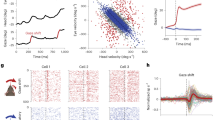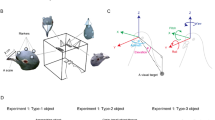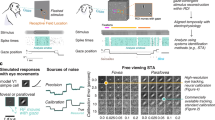Abstract
Fusing left and right eye images into a single view is dependent on precise ocular alignment, which relies on coordinated eye movements. During movements of the head this alignment is maintained by numerous reflexes. Although rodents share with other mammals the key components of eye movement control, the coordination of eye movements in freely moving rodents is unknown. Here we show that movements of the two eyes in freely moving rats differ fundamentally from the precisely controlled eye movements used by other mammals to maintain continuous binocular fusion. The observed eye movements serve to keep the visual fields of the two eyes continuously overlapping above the animal during free movement, but not continuously aligned. Overhead visual stimuli presented to rats freely exploring an open arena evoke an immediate shelter-seeking behaviour, but are ineffective when presented beside the arena. We suggest that continuously overlapping visual fields overhead would be of evolutionary benefit for predator detection by minimizing blind spots.
This is a preview of subscription content, access via your institution
Access options
Subscribe to this journal
Receive 51 print issues and online access
$199.00 per year
only $3.90 per issue
Buy this article
- Purchase on Springer Link
- Instant access to full article PDF
Prices may be subject to local taxes which are calculated during checkout






Similar content being viewed by others
References
Hughes, A. A schematic eye for the rat. Vision Res. 19, 569–588 (1979)
Legg, C. R. & Lambert, S. Distance estimation in the hooded rat: experimental evidence for the role of motion cues. Behav. Brain Res. 41, 11–20 (1990)
Berardi, N. & Maffei, L. From visual experience to visual function: roles of neurotrophins. J. Neurobiol. 41, 119–126 (1999)
Zoccolan, D., Oertelt, N., DiCarlo, J. J. & Cox, D. D. A rodent model for the study of invariant visual object recognition. Proc. Natl Acad. Sci. USA 106, 8748–8753 (2009)
Chelazzi, L., Rossi, F., Tempia, F., Ghirardi, M. & Strata, P. Saccadic eye movements and gaze holding in the head-restrained pigmented rat. Eur. J. Neurosci. 1, 639–646 (1989)
Hess, B. J. & Dieringer, N. Spatial organization of the maculo-ocular reflex of the rat: responses during off-vertical axis rotation. Eur. J. Neurosci. 2, 909–919 (1990)
Quinn, K. J., Rude, S. A., Brettler, S. C. & Baker, J. F. Chronic recording of the vestibulo-ocular reflex in the restrained rat using a permanently implanted scleral search coil. J. Neurosci. Methods 80, 201–208 (1998)
Russell, J. T. Depth discrimination in the rat. Pedagog. Semin. J. Gen. Psychol. 40, 136–161 (1932)
Morris, P. Rats in the diet of the barn owl (Tyto alba). J. Zool. 189, 540–545 (1979)
Doncanster, C. P., Dickman, C. R. & Macdonald, D. W. Feeding ecology of red foxes (Vulpes vulpes) in the city of Oxford, England. J. Mamm. 71, 188–194 (1990)
Fuller, J. H. Eye and head movements in the pigmented rat. Vision Res. 25, 1121–1128 (1985)
Prusky, G. T., Silver, B. D., Tschetter, W. W., Alam, N. M. & Douglas, R. M. Experience-dependent plasticity from eye opening enables lasting, visual cortex-dependent enhancement of motion vision. J. Neurosci. 28, 9817–9827 (2008)
Euler, T. & Wassle, H. Immunocytochemical identification of cone bipolar cells in the rat retina. J. Comp. Neurol. 361, 461–478 (1995)
Hughes, A. in Handbook of Sensory Physiology Vol. VII (ed. Crescitelli, F. ) 613–756 (Springer, 1977)
Leigh, R. J. & Zee, D. S. The Neurology of Eye Movement 3rd edn (Oxford Univ. Press, 1999)
Duwaer, A. L. & van den Brink, G. What is the diplopia threshold? Percept. Psychophys. 29, 295–309 (1981)
Lyle, T. K. & Foley, J. Subnormal binocular vision with special reference to peripheral fusion. Br. J. Ophthalmol. 39, 474–487 (1955)
Dell’Osso, L. F. & Daroff, R. B. Two additional scenarios for see-saw nystagmus: achiasma and hemichiasma. J. Neuro-Ophthalmol. 18, 112–113 (1998)
Douglas, R. M. et al. Independent visual threshold measurements in the two eyes of freely moving rats and mice using a virtual-reality optokinetic system. Vis. Neurosci. 22, 677–684 (2005)
Hughes, A. The refractive state of the rat eye. Vision Res. 17, 927–939 (1977)
Anjum, F., Turni, H., Mulder, P. G., van der Burg, J. & Brecht, M. Tactile guidance of prey capture in Etruscan shrews. Proc. Natl Acad. Sci. USA 103, 16544–16549 (2006)
Wallace, D. G., Gorny, B. & Whishaw, I. Q. Rats can track odors, other rats, and themselves: implications for the study of spatial behavior. Behav. Brain Res. 131, 185–192 (2002)
Munz, M., Brecht, M. & Wolfe, J. Active touch during shrew prey capture. Front. Behav. Neurosci. 4, 191 (2010)
Artal, P., Herreros de Tejada, P., Munoz Tedo, C. & Green, D. G. Retinal image quality in the rodent eye. Vis. Neurosci. 15, 597–605 (1998)
Fernandez-Juricic, E. et al. Testing the terrain hypothesis: Canada geese see their world laterally and obliquely. Brain Behav. Evol. 77, 147–158 (2011)
Dawkins, M. S. What are birds looking at? Head movements and eye use in chickens. Anim. Behav. 63, 991–998 (2002)
Wurtz, R. H. Neuronal mechanisms of visual stability. Vision Res. 48, 2070–2089 (2008)
Acknowledgements
We thank W. Denk, R. Hahnloser, K. Kirchfeld, K. Martin, A. Schwartz and F. Wolf for comments on earlier versions of this manuscript and M. Rictis for help with electronics fabrication. We also thank A. Benali, A. Brauer, U. Czubayko, M.-L. Silva, V. Pawlak, V. Ramachandra and T. Senkova from the Network Imaging Group for data processing, A. Schaefer and M. Köllö for loan of the spherical treadmill, and F. Wolf for advice on the modelling and discussions throughout the project. We thank N. Logothetis for support and C. Sakmann for insights. G.N.’s salary was financed by the German Federal Ministry of Education and Research (BMBF; FKZ: 01GQ1002). The Max Planck Society financed research. We apologize to all authors whom we have not been able to cite because of space restrictions.
Author information
Authors and Affiliations
Contributions
Experimental design was by D.J.W., D.S.G., J.S. and J.N.D.K., hardware and software development by D.S.G. and J.S., data collection by D.J.W., D.S.G., J.S. and S.R., analysis design and implementation by D.J.W., D.S.G., G.N., S.R. and J.N.D.K., methods text by D.J.W., D.S.G., J.S. and G.N. and composition of the main text by D.J.W. and J.N.D.K.
Corresponding author
Ethics declarations
Competing interests
The authors declare no competing financial interests.
Supplementary information
Supplementary Information
This file contains Supplementary Text (see contents pages for details), Supplementary References and Supplementary Figures 1-14. (PDF 8348 kb)
Eye movements in a freely moving rat
Video-oculography of the right and left eyes of the animal (left) and kinetic traces of the recorded eye movements (right) for the same segment of data shown in Fig. 1b. In the kinetic traces, the horizontal position of the marker represents the horizontal position of the pupil, while the color of the marker represents the vertical position. The time axis points downwards. (MP4 1038 kb)
Example of ocular torsion in a freely moving rat
Video of the right eye of one animal, showing the tracked margin of the pupil (blue) and a reference line (red) to aid in visualization of the torsional rotation. (MP4 993 kb)
Eye movements in a head-restrained rat
Video-oculography of the right and left eyes (left) and kinetic traces of the recorded eye movements (right) for the same segment of data as shown in Fig. 1e. The data shown in this video and that in supplementary video 2 are from the same animal. In the kinetic traces, the horizontal position of the marker represents the horizontal position of the pupil, while the color of the marker represents the vertical position. The time axis points downwards. (MP4 455 kb)
Example of eye movements resulting from pitch and roll in of a head-restrained animal
Overhead view showing both eyes of a head-restrained animal, and the eye movements resulting from nose-up pitch, nose-down pitch, rightward roll and leftward roll (each rotation is made from 0 to 60 degrees, then returned to 0). (MP4 6728 kb)
Example showing the constantly changing ocular alignment occurring during free movement
Video-oculography images of the right and left eye (upper) and corresponding ocular alignment represented as gaze vector difference (lower plot, right eye gaze vector – left eye gaze vector) for a short image sequence. The un-yoked movements of the right and left eyes result in continuously changing ocular alignment. The tracked pupil positions in the upper images are represented by the solid white circles, and the tracked eye corner positions used for eliminating artifacts due to camera movement are shown as solid red circles. The image sequence is presented in slow motion, with relative time from the beginning of the sequence shown below the left eye image. (MP4 1001 kb)
“Rat’s eye view” reconstructed from data from one animal during a jump across the gap in the visually-based gap-crossing task
Image sequence showing the left eye (left) and right eye (right) fields of view of one animal as it jumped across the gap. Images were rendered using a spherical projection of the jumping track and surrounding environment, using head position as the optical center and the left or right gaze vector as the optical axis. The projection was based on the actual head and eye positions measured during the jump, and assumed a full field of view for each eye of 180˚. (MP4 1314 kb)
Behavioral responses to visual stimuli presented beside the animal or overhead
Video showing rat behavior in response to stimuli presented beside (on monitors located to the right side, behind and to the left of the arena) or overhead (monitor located above the arena). Stimuli presented beside the arena evoke no obvious behavioral responses, while stimuli presented overhead evoke a strong shelter-seeking response. (MP4 4748 kb)
Example of camera movement and eye corner tracking methodology
Video-oculography (upper images) and corresponding tracked pupil positions (lower plots) from an image sequence containing a gross movement of the right eye camera caused by the animal bumping the camera into the edge of the track. The tracked pupil positions in the upper images are represented by the solid white circles, and the tracked eye corner positions used for eliminating artifacts due to camera movement are shown as solid red circles. The image sequence is presented in slow motion, with relative time from the beginning of the sequence shown to the right of the left eye image. The camera movement in the right eye image occurs at t = 0.310 s. Note that the large camera movement is eliminated from the tracked position of the right pupil. (MP4 416 kb)
Rights and permissions
About this article
Cite this article
Wallace, D., Greenberg, D., Sawinski, J. et al. Rats maintain an overhead binocular field at the expense of constant fusion. Nature 498, 65–69 (2013). https://doi.org/10.1038/nature12153
Received:
Accepted:
Published:
Issue Date:
DOI: https://doi.org/10.1038/nature12153
This article is cited by
-
Interactions between rodent visual and spatial systems during navigation
Nature Reviews Neuroscience (2023)
-
Panoramic visual statistics shape retina-wide organization of receptive fields
Nature Neuroscience (2023)
-
Neurocircuitry of Predatory Hunting
Neuroscience Bulletin (2023)
-
Distribution and postnatal development of chondroitin sulfate proteoglycans in the perineuronal nets of cholinergic motoneurons innervating extraocular muscles
Scientific Reports (2022)
-
Head-tracking of freely-behaving pigeons in a motion-capture system reveals the selective use of visual field regions
Scientific Reports (2022)
Comments
By submitting a comment you agree to abide by our Terms and Community Guidelines. If you find something abusive or that does not comply with our terms or guidelines please flag it as inappropriate.



